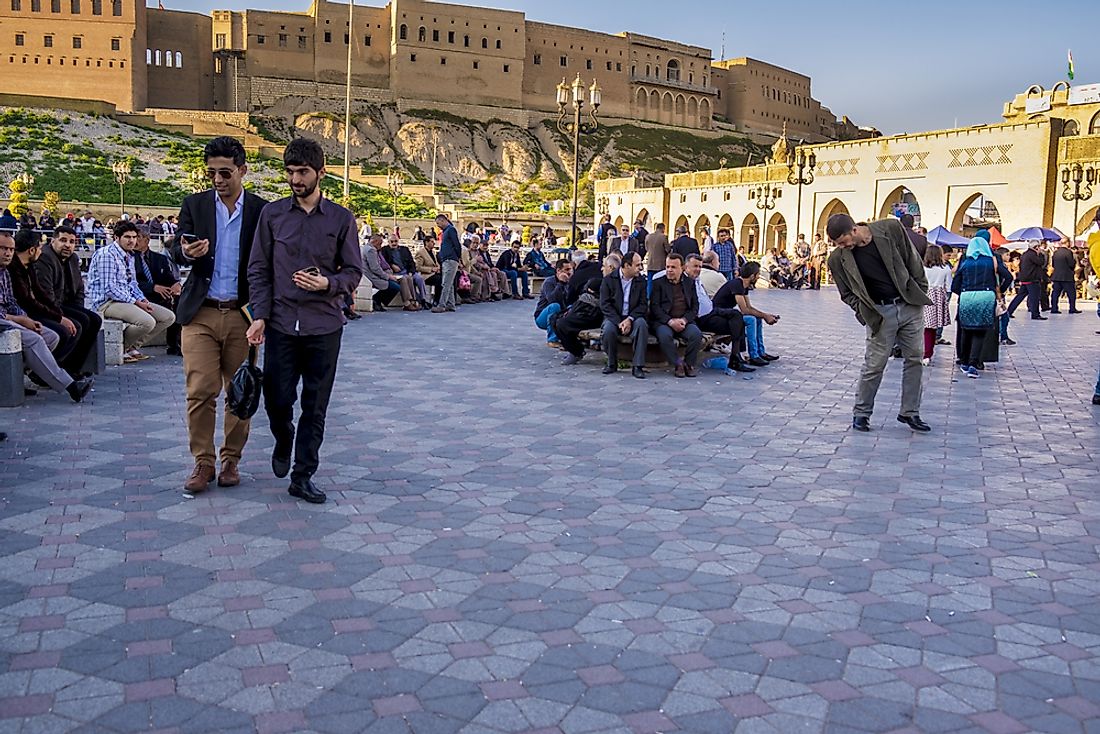Largest Ethnic Groups In Iraq

Iraq has an estimated population of 32,585,692 according to 2014 figures, and almost 80% of these are Arabs. Iraqi Arabs are followed in number in the country by Kurds, while numerous other groups comprise the remainder. Around 99% of the total population is Muslim, Christians constitute 0.8%, and others belong to smaller minority religious groups. The dominant ethnic group is the Mesopotamian Arabs. These Arabs are a fusion of old Mesopotamian, Arabian, Iranian, and other populations who speak the old Mesopotamian Arab. The official language of Iraq is Arabic and Kurdish which are the languages of the two largest communities in the country.
Arabs
Modern Iraqi Arabs descended from a clustered group of peoples known as the Levant Arabs. Levant Arabs initially settled at the Arabian Peninsula and later migrated to North Africa. The Arabian culture developed from the tribes of nomads and villagers who lived in the Arabian Desert several hundred years ago. They speak Semitic language. They coexist as two groups, Sunni and Shiite Arabs. This division resulted from a split over who would inherit the leadership of Muslims after the death of Prophet Mohammad. This disagreement eventually led to a power struggle between the two. However, the Shiite Muslim dominates the Arabic population of Iraq.
Kurds
Kurds trace their origins to the ancient Middle East. It is an independent ethnic group in Iraq and has a population of approximately 4 million people. They are descendants of various Indo-European tribes that arrived in Iraq around 4,000 years ago. The Arabs named them 'Kurds' after they conquered the region. Later, they fell under the Ottoman rule. The Kurds originally lived in the present day turkey, Iran, Syria, and Iraq. The Iraqi Kurdistan is an autonomous region in the northern part of Iraq covering an area of 15,692 square miles. The Kurdish people now live around the Zagros Mountains. Originally the Kurds were followers of Zoroastrianism, Mithraism, and local pagan beliefs. After the Arab overpowered them, Islam slowly dominated the Kurds. Today, most Kurds are Sunni Muslims with a minority population of Shiite Muslims. The majority of the Kurds speak the Kurdish language. Their main dialects are Sorani and Kurmanji. At the national level, the Kurdish identity is strong. Their language became public and was taught in schools, and educational institutions.
Assyrians
The Assyrians once existed as part of a mighty empire which covered parts of what are now northern Iraq, Syria, Turkey, and Iran. Their empire fell between 612BC and 599 BC. During the Sassanid Empire, there was an Assyrian revival leading to the emergence of some independent Assyrian states. It was later dissolved as an entity when the Arab Islam conquests took place. They suffered massacres and discrimination owing to their Christian belief. Most refugees settled in Northern Iraq where they moved toward Kirkuk. The Assyrians speak Aramaic language. In the 1970s, the Ba'ath regime tried to recognize the Assyrians by ordering that Aramaic language be taught in schools, but it failed. Their Christian religion is also significantly discriminated against in the large Islamic population in Iraq. After the fall of Saddam Hussein, the Assyrians formed Assyrian Democratic Movement which was one of the smallest parties. Over two-thirds of the Assyrian Christian population has fled the country.
Turkmen
Turkmen originated from Central Asia and settled in Iraq. This migration took place in three phases. The first phase was in the 7th Century when Oghuz Turks served in the Muslim army. The second phase was the Turks of the Great Seljuq Empire during the repair of the holy road to Mecca. The last wave was Turks of the Ottoman Empire under the reign of Suleiman the Magnificent. The Turkmen speak a dialect that is considered to be either a South Azeri dialect or an intermediate between the South Azeri and the standard Turkish. Many of them are bilingual or trilingual, speaking Arabic and Kurdish. The majority of them are Muslims. They mostly occupy the northern and central regions of Iraq. The Turkmen were originally the administrative and business classes of the Ottoman Empire. Today they are an increasingly discriminated ethnic group in Iraq. They have been victims of several massacres, such as the Kirkuk massacres of 1924 and 1959. The government of Iraq tried to assimilate the Turkmen through "Arabization" in 1990 by the Arabs and a subsequent "Kurdification" in 1991. Today, they are no longer tribally organized due to the assimilation policies imposed upon them.
Ethnic Conflict
The Arabs dominate the population of Iraq, and thus have the greatest sway and impact in the country. Their Semitic language and the Muslim religion and culture dominate other minority populations. The Sunni are an Islamic minority group in Iraq as the Shiite is the majority group. There exists a continual battle between the Arabs and the Kurds leading to a survivalist mentality for the Kurds. The Turkmen also experience a strained relationship with the Kurds as they historically acted as buffers between Arabic and Kurdish areas. There are also the Yazidis, which are believed to be of Kurdish decent, as well as Persians, Kawliya, Armenians, Mandeans, Shabakis, and Circassians, among others.







